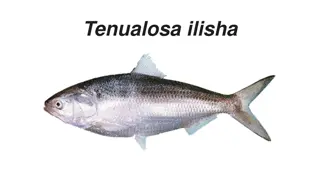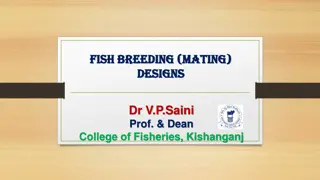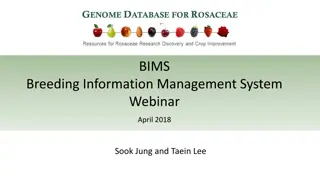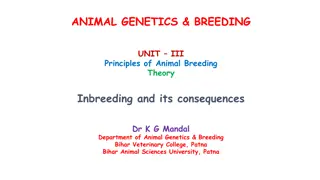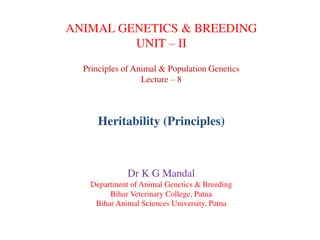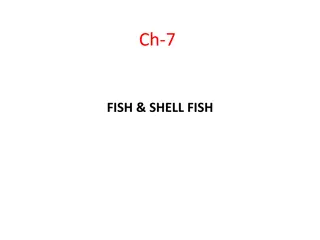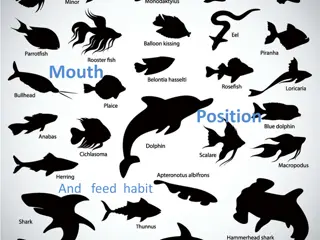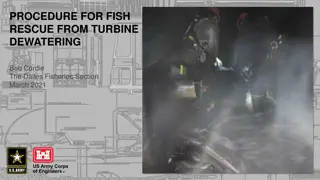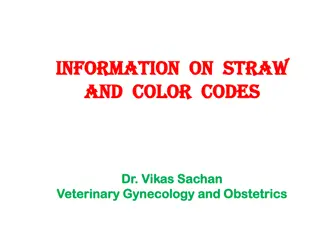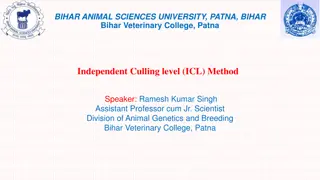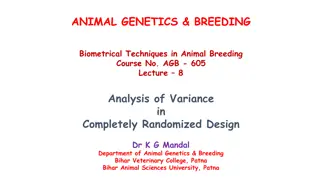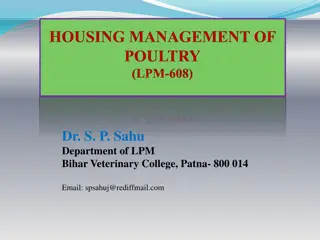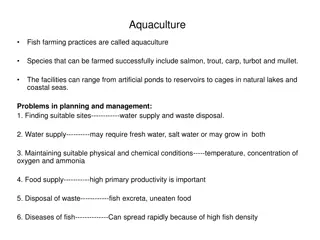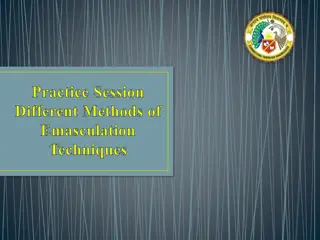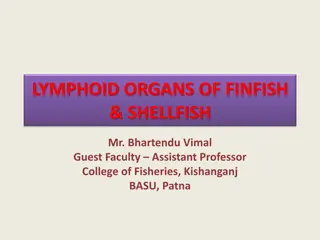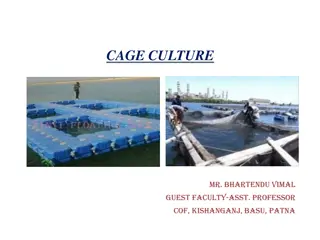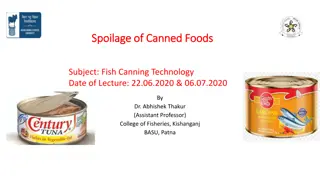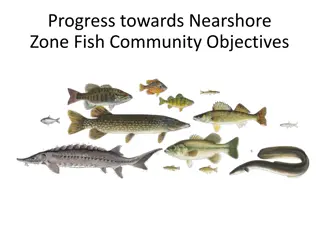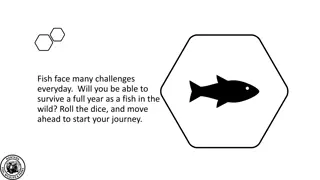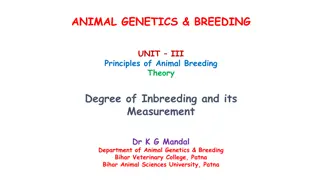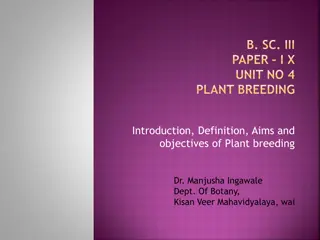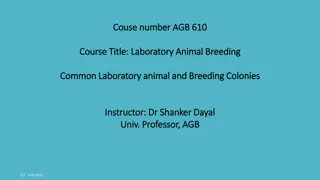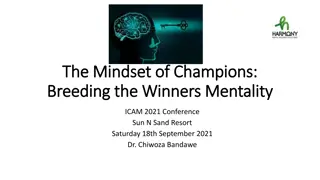Fish Breeding and Spawn Management Techniques by Dr. S.P. Sahu
Dr. S.P. Sahu, an Assistant Professor at Bihar Veterinary College in Patna, provides valuable insights into fish breeding and spawn management. The content covers fish seed collection, procurement methods, fry identification, and confined water breeding techniques. Detailed information on Indian major carps, their classification based on size, and seasonal fry collection in West Bengal, Orissa, and Bihar is discussed. The article emphasizes the importance of proper identification of desirable fish species during fry collection. Additionally, it delves into the process of spawning, hatching of embryos, and the use of bundhs for breeding fish under controlled conditions.
Download Presentation

Please find below an Image/Link to download the presentation.
The content on the website is provided AS IS for your information and personal use only. It may not be sold, licensed, or shared on other websites without obtaining consent from the author. Download presentation by click this link. If you encounter any issues during the download, it is possible that the publisher has removed the file from their server.
E N D
Presentation Transcript
FISH BREEDING AND SPAWN MANAGEMENT Dr. S.P. Sahu Assistant Professor (LPM) Bihar Veterinary College, Patna
Fish Seed Collection Classification of Indian major carps based on size only: Spawn/hatchling Early fry Fry Fingerling Advanced fingerling : upto 8 mm : 8-25 mm : 25-40 mm : 40-100 mm : 100-150 mm
Procurement of Fish Seed Stock 1. Natural fish seed collection: From rivers: Indian major carps. Breeding during monsoon season. Breeding period is 3 days before or after full moon/ new moon fromApril-July with four periods of maximum breeding. Seed is collected as it drifts down the river with current. Collection: Shallow water near the bank with weak current or in pits connected to river.
Fry collection season in West Bengal, Orissa and Bihar: July-September. Fry collection gear consists of a funnel shaped fine meshed net called Benchi Jal. Net has 2 parts: net proper and gamcha. Spawn is collected every half to one hour to prevent overcrowding of spawn in gamcha. One spawn net: 15 battis (20,000-60,000 larvae). Carps fry collected from rivers is mixture of various desirable and undesirable species of fishes. Needs identification for segregation of desirable species of fry. Difficult to identify before 3 cm size.
Identification of fry of Indian carps: Catla: Head large at 11.3 mm stage and broad from 17.8 mm stage, no barbels, reddish gill visible through transparent operculum. Rohu: Normal size head, spots on caudal peduncle not enclosing whitish area, lips fringed, body without longitudinal bands and fins marked with vermillion red.
Mrigal: Normal size head, spots on caudal peduncle not enclosing whitish area, lips entire, margin of lips rather whitish, body marked with several bands. longitudinal black Calbasu: Normal size head, 3-4 black spots on caudal peduncle enclosing white space, lips fringed, colour greyish, yellowish spot at the front of base of dorsal fin, a yellowish band at the nape and black barbels.
2. Confined Water (Bundh) Breeding: Spawning and hatching of embryos: in bundhs. Bundhs: A type of tank where running water conditions simulated during monsoon months to induce the fishes to breed under captivity. (a) Dry Bundh Shallow seasonal pond or a depression of varying size and shape adjoining and upland and enclosed by an earthen wall on three/four sides with a catchment area on one side. Gets flood water during monsoon from the upland catchment areas but remains dry for most part of years.
Ratio of bundh proper and catchment area: 1:5-25 depending upon rainfall and topography. Sufficient quantity of water is stored in bundh and brood fishes are introduced. Spawning occurs during and after heavy showers. After breeding is over, bundh is partially drained and eggs are collected for hatching by mosquito nets.
Collected eggs are transferred in small earthen pits with mud plastered walls called chaba for hatching. Size of chaba: 3 x2 x1 . 2-3 litters of fertilized eggs (50-75 thousand) is kept in each pit and water from reservoir is circulated through the pits. Hatching: 15-20 hrs after fertilization. Hatchlings are collected from chaba by muslin cloths and transferred to bigger sized earthen pits called hamar (2-3 lakh hatchlings/hamar). Selling of hatchlings: after 48 hrs.
Sympathetic Breeding Before initiation of breeding programme, 30-60 cm water is allowed to accumulated in dry bundh through inlet. Mature males and gravid females (1:1) are selected and introduced in dry bundh and left undisturbed for 6-12 hrs. i/m injection of pituitary extract @5-10mg/kg BW administered in single dose to 10- 20% both males and females. Simulation rainy conditions by water gushes from guarded inlet and outlet. Sexual play: starts 4-6 hrs after injection. Breeding continues for 4-6 hrs mostly by all fishes kept in the bundh irrespective of injection. This phenomena is k/a sympathetic breeding.
Bangla Bundh For breeding of both Indian major carps and exotic carps in definite sized rectangular (23x6 sq. m.) mini-bundhs. Mini-bundh having a deeper zone (1.4m) for harbour brood fishes and a shallower zone (0.3-0.75m) acts as spawning ground. 10-13 cm of coarse sand uniformly spread over the shallower zone to facilitate natural breeding. Rainy condition simulation by iron pipes at one/both sides of bundh. Female brood fishes: preparatory dose 5-6 hrs before second injection of pituitary gland extract. Male: only injected when female gets final dose.
(b) Wet Bundh Perennial pond located in the slope of vast catchment area with proper embankment. Having inlets towards upland and outlets towards the other adjacent fields. Shallow area: breeding ground for fishes present in bundhs. Catchment area: 20-100 times. Construction of wet bundh is very expensive and not profitable.
3. Induced Breeding/Hypophysation Used in Indian carps and exotic carps. Can't breed in general fish ponds. Induced breeding by injection of pituitary gland extract (FSH, LH, HCG- gonad maturation, ovulation, spermiation). Collected from fresh/preserved mature fishes from head. Preserved in alcohol. Soluble in water. After 24 hrs. again transferred in separate phials with fresh absolute alcohol. Later, weighed, graded for potency and serially numbered.
Rearing of brood stock in perennial ponds after eradication of predatory/unwanted fishes, aquatic weeds. Liming, manuring of pond. Introduction of brood fishes of 2.4 kg body size during post winter months of jan-Feb when temp. gradually increases. Feed Supplementation @1.2% of BW (oil cake and rice bran- 1:1). Males differentiated by denticulations and roughness of dorsal side of pectoral fin- longer and stronger than females.
Selection of brood fishes for spawning: fully ripe male freely oozes milt by gentle abdominal pressure. Spawner females are recognized by larger bulging soft abdomen and swollen reddish genital opening. Preparation of gland extract and ampouling: by determination of proper dose, quantity of gland required for injection a/c body wt. of fishes. Requisite homogenized in distilled water- centrifuged-remove tissue particles from bottom- supernatant fluid collected (hormone)- ampouled with glycerin preservatve (1 amp.- 40mg pituitary extract). quantity- taken from phial-macerated and
Administration of extract: I/M inj in the region of caudal peduncle just above lateral line. Use hypodermic syringe or needle 22 for smaller fishes and 19 for larger fishes (>3kg). Dosage same as sympathetic breeding. Kept for breeding inside the hapa having water temperature of 24-33oC. Spawning takes place within 3-6 hrs of final injection. Fertilization takes place in water. Fertilized spawn is collected for hatching after 4-6 hrs of fertilization in hatching cloth hapa or hatchery.
AGE AND GROWTH OF FISHES Objectives To calculate the time of sexual maturity of different species. To know their spawning time. To study the suitability of particular species for a particular type of the water-body according to growth rate of fish. Forms the basis for calculations leading to a knowledge of the growth, mortality, recruitment and other fundamental parameters of their populations.
Determination of age and growth of fishes are important aspects in the development of fisheries. As the fish ages, it grows, but after attaining a particular size, growth stops. Age gives an idea about sexual maturity, spawning time, catchable size, growth rate and longevity. Growth of fish is the change in length and weight with increase of age as a result of metabolism of nutrition. Hence growth is an index of healthy food and oxygen supply in the water- body. Proper growth of fish also indicates that the water body is devoid of any pollution.
Methods of Age and Growth Determination 1. Scale Method: Most commonly used for determination of age of osteichthyes (bony fish), which are provided with cycloid and ctenoid scales. The structure of scale and its development is useful in the interpretation of growth zones. The structure of scale can be seen very easily under the microscope after washing with dilute solution of caustic soda followed by staining with borax carmine. A well-developed scale has a Focus (in the centre), Circuli (concentric rings present around the focus), Grooves (between the ridges of circuli), Radii (run from focus to margin of scale) and Annuli (wide circular troughs found in aged fish over one year).
Applications of Scale Method: Fish of temperate regions shows clear rings, which are true marks. This is because there is a sharp difference between the temperatures of two seasons summer the period of faster growth, and winter the period of slow growth or no growth. Therefore, the calculation of the age of fish by annuli is most reliable in temperate fish. This method is more reliably applicable in case of salmons, carps, cod and herrings, established a method of estimating age of fish based on scales.
2. Bone Method: Annuli are also present on some bones. The important bones such as operculum, vertebra, supra occipital and scapula are provided with annulations. These annuli are increased in number with the age of fish. The growth rate is different in different seasons. Number of annual rings are helpful in calculating the age of fish. Similarly, the centrum of fish is also helpful in calculating the age of fish. The centrum of fish vertebrae possess rings, which are used in age determination. For counting the rings on the centrum, it is exposed by removing the tissues attached to it using solution of 0.7% pepsin in 0.2% of hydrochloric acid. The rings on the centrum are counted under the microscope.
3. Otolith Method: The otolith or ear-stone is present in the internal ear of the fishes and helps in balancing the body. The otolith has annulations formed by the regular deposition of calcium salts. The formation of annulations varies with the growth of fish and the growth of fish varies with the season. The growth rate of fish is faster in the summer as compared to the winters, thus annulations formation is faster in the summer. To get the otolith, fish is killed and dissected and otolith is taken out and annulations are counted. For this, first of all the otolith is broken and cut in transverse plane followed by polishing with liquid of high refractive index, such as immersion oils, creosote, etc. The otolith thus prepared is examined under the microscope to count the annulations for age determination and the growth rate analysis.
4. Known Age Method: The determination of growth rate through this method requires the knowledge of age, which can be known from time of breeding. The hatchlings are kept in a tank in appropriate conditions for two or three seasons. The growth is measured periodically. The fishes are marked with tags and reintroduced in the water. The fishes are recaptured at regular intervals and idea of growth rate in relation of the time is taken.
5. Pectoral Spine or Fin Ray Method: Spines of the pectoral fin is also useful in age determination. For this 3 to 4 thick sections of spines are cut and mounted in glycerin and then observed in the microscope. 1% to 2% of indistinct annuli or fin ray consistency are compared to 15% to 20% of annuli on the scales and thus age is calculated.




